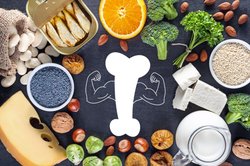Bone density is a vital element of a healthy musculoskeletal system, helping your orthopedic specialist determine how durable your bones are. When bones begin to lose their density, they can become brittle, prone to deterioration, and vulnerable to fractures. While aging can be a natural factor in bone density loss, there are also external, controllable factors that can determine how strong your bones are—and proper nutrition is one of them.
At OAA Orthopedic Specialists, our board-certified, fellowship trained physicians want our patients to be educated on all the ways they can keep their musculoskeletal system strong as well as to understand the benefits of nutrition in healing from an injury!
Here are some great ways you can incorporate healthy foods into your everyday diet for your bone health:
Make Sure to Keep it Green
Leafy greens are an important part of any health-forward diet, but did you know that certain types of greens can be specifically beneficial to your bones and musculoskeletal system overall? Kale and spinach are both extremely rich in calcium and vitamin K, both of which are essential for strong bones. They can be incorporated into your diet in a wide variety of delicious ways, from tasty green smoothies to your new favorite salad mix.
While these are the top two leafy greens when it comes to calcium, you can’t go wrong with broccoli or collard greens to add some variety while giving your bones a boost.
Go Nuts With the Nuts
If you’re a frequent snacker, we have some great news -- nuts are some of the best foods available for boosting your daily calcium intake. Almonds specifically hold tons of nutritious benefits for their tiny package, containing 200mg worth of the average daily recommended dose of calcium.
Walnuts are another excellent choice for an easy-snacking nut that’s rich in the calcium your bones need to stay dense and strong. If you find these nuts a little boring in their plain form, do not worry: there are plenty of delicious ways to incorporate them into your diet. Try using them as a crunchy addition to your morning cereal or as a salad topping (and don’t forget to feature spinach and kale)!
Don’t Skip the Omega-3s
If you’ve heard any conversation around nutrition, you’ve probably heard about “omega-3 foods.” But what are they, actually? Omega-3 foods all contain eicosapentaenoic acid and docosahexaenoic acid, both known as “omega-3 fatty acids,” which can help alleviate symptoms of inflammation for those struggling with arthritis and other orthopedic conditions. These foods are also known to contain large amounts of vitamin D, which is another essential nutrient for your musculoskeletal system’s health.
What are these super-beneficial foods, you ask? Most commonly, fish! Tuna and salmon, two of the most omega-3-rich types of fish, are versatile, delicious additions to your lunch and dinner menus.
Stay Strong With Dairy
You may have already known this one, but we’ll say it again -- dairy is an excellent source of calcium that you should be sure to make plenty of room for in a bone-healthy diet. But dairy doesn’t just mean milk! Cheese and yogurt are equally beneficial when it comes to bone density, sometimes even more so.
Try incorporating skim dairy products as a healthy staple, not just during breakfast but lunch and dinner as well.
Keep Your Bones Strong and Healthy Today!
These nutritional tips for stronger and healthy bones are applicable to anyone looking to craft a healthy diet, but they can be especially important if you’re living with (or at a particularly high risk for) an orthopedic condition such as arthritis or osteoporosis.
If you’re looking for additional guidance on how to keep your bones healthy and strong, reach out to the specialists at OAA for expert advice from a board-certified professional. If you’re ready to start living pain-free, schedule an appointment with us today.
Frequently Asked Questions
How can I protect my bone health?
To prevent bone loss, it is important to consume enough vitamin D and calcium through your diet or supplements, engage in regular exercise that puts stress on your bones, avoid smoking and excessive alcohol consumption, take calcium supplements, and maintain healthy body weight. To build healthy bones, it is recommended to have regular check-ups with your orthopedic specialist.
How does the body absorb calcium?
Calcium absorption occurs in the small intestine, where it is transported into the bloodstream and then deposited into bones. Vitamin D plays a crucial role in this process by helping the body to absorb calcium more efficiently.
What is bone mineral density (BMD)?
Bone mineral density, or BMD, refers to the amount of calcium and other minerals present in your bones. It is used as an indicator of how strong and dense your bones are, with higher levels being associated with better overall bone health. A low BMD can increase the risk of fractures and other bone-related issues.
Why is peak bone mass important for bone health?
Peak bone mass refers to the highest level of bone density that a person can achieve in their lifetime. This typically occurs during young adulthood, and it is essential to reach a high peak bone mass as it provides a foundation for future bone health. The higher the peak bone mass, the less likely you are to experience significant bone loss as you age.

